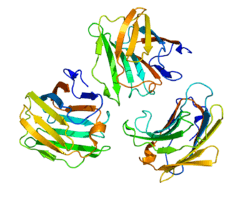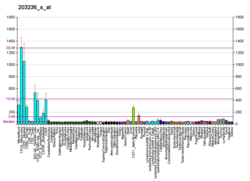Galectin-9
Galectin-9 was first time isolated from mouse embryonic kidney in 1997 as a 36 kDa beta-galactoside lectin protein.[3] Human galectin-9 is encoded by the LGALS9 gene.[4][5]
Function
The protein has N- and C- terminal carbohydrate-binding domains connected by a link peptide. Multiple alternatively spliced transcript variants have been found for this gene.[5]
Galectin-9 is one of the most studied ligand for HAVCR2 (TIM-3) and is expressed on various tumor cells. However, it can also interact with other proteins (CLEC7A,[6] CD137,[7] CD40[8]). For example, an interaction with CD40 on T-cells induced their proliferation inhibition and cell death.
Galectin-9 also has important cytoplasmic, intracellular functions and controls AMPK[9][10] in response to lysosomal damage that can occur upon exposure to endogenous and exogenous membrane damaging agents such as crystalline silica, cholesterol crystals, microbial toxins, proteopathic aggregates such as tau fibrils and amyloids, and signaling pathways inducing lysosomal permeabilization such as those initiated by TRAIL.[11] Mild lysosomal damage, such as that caused by the anti-diabetes drug metformin[10] may contribute to the therapeutic action of metformin by activating AMPK. The mechanism of how Galectin-9 activates AMPK involves recognition of exposed lysosomal lumenal glycoproteins such as LAMP1, LAMP2, SCRAB2, TMEM192, etc., repulsion of deubiquitinating enzyme USP9X, increased K63 ubiquitination of TAK1 (MAP3K7) kinase, which in turn phopshorylates AMPK and activates it.[10] This signaling cascade directly links Galectin-9 intracellular function with ubiqutin systems. Galectin-9, thorugh its regulation of AMPK, a kinase that negatively regulates mTOR, cooperates with Galectin-8-based effects to inactivate mTOR downstream of the lysosomal damaging agents and conditions.[9][10]
Clinical significance
The expression of galectin-9 has been detected on various hematological malignancies, such as CLL,[12] MDS,[13] Hodgkin and Non-Hodgkin lymphomas,[14] AML[15] or solid tumors, such as lung cancer,[16] breast cancer,[17] and hepatocellular carcinoma.[18]
HAVCR2/ galectin-9 interaction attenuated T-cell expansion and effectors function in tumor microenviroment and chronic infections.[19][15] Moreover, galectin-9 contributed to tumorigenesis by tumor cell transformation, cell-cycle regulation, angiogenesis, and cell adhesion.[20] The correlative studies analyzing the expression of galectin-9 and malignant clinical features showed controversial results. This can be explained as that galectin-9 can promote tumor immune escape as well as inhibit metastasis by promoting endothelial adhesion.[18] Therefore many factors such as tumor type, stage, and the involvement of different galectins should be take into consideration when correlating the expression level and the malignancy.
Galectin-9, through its cytoplasmic action in control of AMPK,[9][10] may affect various health conditions impacted by AMPK, including metabolism, obesity, diabetes, cancer, immune responses, and may be a part of the mechanism of action of the widely-prescribed anti-diabetis drug metformin.[10]
References
- GRCh38: Ensembl release 89: ENSG00000168961 - Ensembl, May 2017
- "Human PubMed Reference:". National Center for Biotechnology Information, U.S. National Library of Medicine.
- Wada J, Kanwar YS (February 1997). "Identification and characterization of galectin-9, a novel beta-galactoside-binding mammalian lectin". The Journal of Biological Chemistry. 272 (9): 6078–86. doi:10.1074/jbc.272.9.6078. PMID 9038233.
- Türeci O, Schmitt H, Fadle N, Pfreundschuh M, Sahin U (March 1997). "Molecular definition of a novel human galectin which is immunogenic in patients with Hodgkin's disease". The Journal of Biological Chemistry. 272 (10): 6416–22. doi:10.1074/jbc.272.10.6416. PMID 9045665.
- "Entrez Gene: LGALS9 lectin, galactoside-binding, soluble, 9 (galectin 9)".
- Daley D, Mani VR, Mohan N, Akkad N, Ochi A, Heindel DW, et al. (May 2017). "Dectin 1 activation on macrophages by galectin 9 promotes pancreatic carcinoma and peritumoral immune tolerance". Nature Medicine. 23 (5): 556–567. doi:10.1038/nm.4314. PMC 5419876. PMID 28394331.
- Madireddi S, Eun SY, Lee SW, Nemčovičová I, Mehta AK, Zajonc DM, Nishi N, Niki T, Hirashima M, Croft M (June 2014). "Galectin-9 controls the therapeutic activity of 4-1BB-targeting antibodies". The Journal of Experimental Medicine. 211 (7): 1433–48. doi:10.1084/jem.20132687. PMC 4076583. PMID 24958847.
- Vaitaitis GM, Wagner DH (2012). "Galectin-9 controls CD40 signaling through a Tim-3 independent mechanism and redirects the cytokine profile of pathogenic T cells in autoimmunity". PLOS ONE. 7 (6): e38708. doi:10.1371/journal.pone.0038708. PMC 3369903. PMID 22685601.
- Jia J, Abudu YP, Claude-Taupin A, Gu Y, Kumar S, Choi SW, et al. (April 2018). "Galectins Control mTOR in Response to Endomembrane Damage". Molecular Cell. 70 (1): 120–135.e8. doi:10.1016/j.molcel.2018.03.009. PMC 5911935. PMID 29625033.
- Jia J, Bissa B, Brecht L, Allers L, Choi SW, Gu Y, et al. (January 2020). "AMPK, a Regulator of Metabolism and Autophagy, Is Activated by Lysosomal Damage via a Novel Galectin-Directed Ubiquitin Signal Transduction System". Molecular Cell: S109727651930958X. doi:10.1016/j.molcel.2019.12.028.
- Werneburg NW, Guicciardi ME, Bronk SF, Kaufmann SH, Gores GJ (September 2007). "Tumor necrosis factor-related apoptosis-inducing ligand activates a lysosomal pathway of apoptosis that is regulated by Bcl-2 proteins". The Journal of Biological Chemistry. 282 (39): 28960–70. doi:10.1074/jbc.M705671200. PMID 17686764.
- Taghiloo S, Allahmoradi E, Ebadi R, Tehrani M, Hosseini-Khah Z, Janbabaei G, Shekarriz R, Asgarian-Omran H (August 2017). "Upregulation of Galectin-9 and PD-L1 Immune Checkpoints Molecules in Patients with Chronic Lymphocytic Leukemia". Asian Pacific Journal of Cancer Prevention. 18 (8): 2269–2274. doi:10.22034/APJCP.2017.18.8.2269. PMC 5697491. PMID 28843266.
- Asayama T, Tamura H, Ishibashi M, Kuribayashi-Hamada Y, Onodera-Kondo A, Okuyama N, Yamada A, Shimizu M, Moriya K, Takahashi H, Inokuchi K (October 2017). "Functional expression of Tim-3 on blasts and clinical impact of its ligand galectin-9 in myelodysplastic syndromes". Oncotarget. 8 (51): 88904–88917. doi:10.18632/oncotarget.21492. PMC 5687656. PMID 29179486.
- Makishi S, Okudaira T, Ishikawa C, Sawada S, Watanabe T, Hirashima M, Sunakawa H, Mori N (August 2008). "A modified version of galectin-9 induces cell cycle arrest and apoptosis of Burkitt and Hodgkin lymphoma cells". British Journal of Haematology. 142 (4): 583–94. doi:10.1111/j.1365-2141.2008.07229.x. PMID 18503581.
- Gonçalves Silva I, Yasinska IM, Sakhnevych SS, Fiedler W, Wellbrock J, Bardelli M, Varani L, Hussain R, Siligardi G, Ceccone G, Berger SM, Ushkaryov YA, Gibbs BF, Fasler-Kan E, Sumbayev VV (August 2017). "The Tim-3-galectin-9 Secretory Pathway is Involved in the Immune Escape of Human Acute Myeloid Leukemia Cells". EBioMedicine. 22: 44–57. doi:10.1016/j.ebiom.2017.07.018. PMC 5552242. PMID 28750861.
- Gao J, Qiu X, Li X, Fan H, Zhang F, Lv T, Song Y (February 2018). "Expression profiles and clinical value of plasma exosomal Tim-3 and Galectin-9 in non-small cell lung cancer". Biochemical and Biophysical Research Communications. 498 (3): 409–415. doi:10.1016/j.bbrc.2018.02.114. PMID 29452091.
- Irie A, Yamauchi A, Kontani K, Kihara M, Liu D, Shirato Y, Seki M, Nishi N, Nakamura T, Yokomise H, Hirashima M (April 2005). "Galectin-9 as a prognostic factor with antimetastatic potential in breast cancer". Clinical Cancer Research. 11 (8): 2962–8. doi:10.1158/1078-0432.CCR-04-0861. PMID 15837748.
- Zhang ZY, Dong JH, Chen YW, Wang XQ, Li CH, Wang J, Wang GQ, Li HL, Wang XD (2012). "Galectin-9 acts as a prognostic factor with antimetastatic potential in hepatocellular carcinoma". Asian Pacific Journal of Cancer Prevention. 13 (6): 2503–9. doi:10.7314/apjcp.2012.13.6.2503. PMID 22938412.
- Sakuishi K, Apetoh L, Sullivan JM, Blazar BR, Kuchroo VK, Anderson AC (September 2010). "Targeting Tim-3 and PD-1 pathways to reverse T cell exhaustion and restore anti-tumor immunity" (PDF). The Journal of Experimental Medicine. 207 (10): 2187–94. doi:10.1084/jem.20100643. PMC 2947065. PMID 20819927.
- Liu FT (April 2005). "Regulatory roles of galectins in the immune response". International Archives of Allergy and Immunology. 136 (4): 385–400. doi:10.1159/000084545. PMID 15775687.
Further reading
- Hirashima M, Kashio Y, Nishi N, Yamauchi A, Imaizumi TA, Kageshita T, Saita N, Nakamura T (2004). "Galectin-9 in physiological and pathological conditions". Glycoconjugate Journal. 19 (7–9): 593–600. doi:10.1023/B:GLYC.0000014090.63206.2f. PMID 14758084.
- Maruyama K, Sugano S (January 1994). "Oligo-capping: a simple method to replace the cap structure of eukaryotic mRNAs with oligoribonucleotides". Gene. 138 (1–2): 171–4. doi:10.1016/0378-1119(94)90802-8. PMID 8125298.
- Suzuki Y, Yoshitomo-Nakagawa K, Maruyama K, Suyama A, Sugano S (October 1997). "Construction and characterization of a full length-enriched and a 5'-end-enriched cDNA library". Gene. 200 (1–2): 149–56. doi:10.1016/S0378-1119(97)00411-3. PMID 9373149.
- Matsumoto R, Matsumoto H, Seki M, Hata M, Asano Y, Kanegasaki S, Stevens RL, Hirashima M (July 1998). "Human ecalectin, a variant of human galectin-9, is a novel eosinophil chemoattractant produced by T lymphocytes". The Journal of Biological Chemistry. 273 (27): 16976–84. doi:10.1074/jbc.273.27.16976. PMID 9642261.
- Matsumoto R, Hirashima M, Kita H, Gleich GJ (February 2002). "Biological activities of ecalectin: a novel eosinophil-activating factor". Journal of Immunology. 168 (4): 1961–7. doi:10.4049/jimmunol.168.4.1961. PMID 11823532.
- Kageshita T, Kashio Y, Yamauchi A, Seki M, Abedin MJ, Nishi N, Shoji H, Nakamura T, Ono T, Hirashima M (June 2002). "Possible role of galectin-9 in cell aggregation and apoptosis of human melanoma cell lines and its clinical significance". International Journal of Cancer. 99 (6): 809–16. doi:10.1002/ijc.10436. PMID 12115481.
- Imaizumi T, Kumagai M, Sasaki N, Kurotaki H, Mori F, Seki M, Nishi N, Fujimoto K, Tanji K, Shibata T, Tamo W, Matsumiya T, Yoshida H, Cui XF, Takanashi S, Hanada K, Okumura K, Yagihashi S, Wakabayashi K, Nakamura T, Hirashima M, Satoh K (September 2002). "Interferon-gamma stimulates the expression of galectin-9 in cultured human endothelial cells". Journal of Leukocyte Biology. 72 (3): 486–91. PMID 12223516.
- Asakura H, Kashio Y, Nakamura K, Seki M, Dai S, Shirato Y, Abedin MJ, Yoshida N, Nishi N, Imaizumi T, Saita N, Toyama Y, Takashima H, Nakamura T, Ohkawa M, Hirashima M (November 2002). "Selective eosinophil adhesion to fibroblast via IFN-gamma-induced galectin-9". Journal of Immunology. 169 (10): 5912–8. doi:10.4049/jimmunol.169.10.5912. PMID 12421975.
- Kashio Y, Nakamura K, Abedin MJ, Seki M, Nishi N, Yoshida N, Nakamura T, Hirashima M (April 2003). "Galectin-9 induces apoptosis through the calcium-calpain-caspase-1 pathway". Journal of Immunology. 170 (7): 3631–6. doi:10.4049/jimmunol.170.7.3631. PMID 12646627.
- Abedin MJ, Kashio Y, Seki M, Nakamura K, Hirashima M (May 2003). "Potential roles of galectins in myeloid differentiation into three different lineages". Journal of Leukocyte Biology. 73 (5): 650–6. doi:10.1189/jlb.0402163. PMID 12714580.
- Matsuda A, Suzuki Y, Honda G, Muramatsu S, Matsuzaki O, Nagano Y, Doi T, Shimotohno K, Harada T, Nishida E, Hayashi H, Sugano S (May 2003). "Large-scale identification and characterization of human genes that activate NF-kappaB and MAPK signaling pathways". Oncogene. 22 (21): 3307–18. doi:10.1038/sj.onc.1206406. PMID 12761501.
- Irie A, Yamauchi A, Kontani K, Kihara M, Liu D, Shirato Y, Seki M, Nishi N, Nakamura T, Yokomise H, Hirashima M (April 2005). "Galectin-9 as a prognostic factor with antimetastatic potential in breast cancer". Clinical Cancer Research. 11 (8): 2962–8. doi:10.1158/1078-0432.CCR-04-0861. PMID 15837748.
- Kasamatsu A, Uzawa K, Nakashima D, Koike H, Shiiba M, Bukawa H, Yokoe H, Tanzawa H (August 2005). "Galectin-9 as a regulator of cellular adhesion in human oral squamous cell carcinoma cell lines". International Journal of Molecular Medicine. 16 (2): 269–73. doi:10.3892/ijmm.16.2.269. PMID 16012760.
- Dai SY, Nakagawa R, Itoh A, Murakami H, Kashio Y, Abe H, Katoh S, Kontani K, Kihara M, Zhang SL, Hata T, Nakamura T, Yamauchi A, Hirashima M (September 2005). "Galectin-9 induces maturation of human monocyte-derived dendritic cells". Journal of Immunology. 175 (5): 2974–81. doi:10.4049/jimmunol.175.5.2974. PMID 16116184.
- Zhu C, Anderson AC, Schubart A, Xiong H, Imitola J, Khoury SJ, Zheng XX, Strom TB, Kuchroo VK (December 2005). "The Tim-3 ligand galectin-9 negatively regulates T helper type 1 immunity". Nature Immunology. 6 (12): 1245–52. doi:10.1038/ni1271. PMID 16286920.
- van de Weyer PS, Muehlfeit M, Klose C, Bonventre JV, Walz G, Kuehn EW (December 2006). "A highly conserved tyrosine of Tim-3 is phosphorylated upon stimulation by its ligand galectin-9". Biochemical and Biophysical Research Communications. 351 (2): 571–6. doi:10.1016/j.bbrc.2006.10.079. PMID 17069754.



